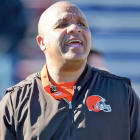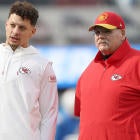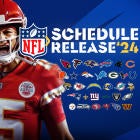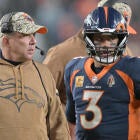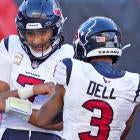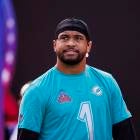NFL teams will have more than $1.2 billion in salary cap space at their disposal when the 2017 league year begins March 9. Typically, winning the free-agent signing period doesn’t translate into on-field success.
That certainly wasn’t the case last season. Armed with almost $60 million in cap room for free agency, the Raiders earned their first playoff berth in 15 seasons thanks to some key free-agent acquisitions: outside linebacker Bruce Irvin, safety Reggie Nelson, guard Kelechi Osemele and cornerback Sean Smith.
Three straight losing seasons spurred Giants general manager Jerry Reese to overhaul a defense that ranked last in the NFL in total and pass defense during the 2015 season. He committed almost $200 million, with more than $105 million in guarantees, to three big-ticket defensive players: defensive tackle Damon Harrison, cornerback Janoris Jenkins and defensive end Olivier Vernon. The spending spree paid off. The Giants made the playoffs as a wild-card team and were responsible for two of the Cowboys’ three regular-season losses.
The NFL’s preliminary projections put the 2017 salary cap between $166 million and $170 million. Each team’s actual salary cap (known as adjusted salary cap) usually is different from the NFL’s set amount because unused cap room can be carried over from one year to the next and other adjustments can further increase or decrease cap space. Teams rarely carry over less than the full amount of the surplus.
This fundamental change from previous collective bargaining agreements (CBA) allowing carry-over has led to more teams annually having an abundance of cap room. The Browns ($50.123M), Jaguars ($39.31M) and 49ers ($38.71M) are carrying over the most unused cap room from the 2016 league year.

Salary cap accounting is different during the offseason than in the regular season. Only the top 51 cap numbers count on the cap until the start of the regular season. In addition to players under contract to a team, the top 51 includes any tenders for franchise/transition players and restricted free agents and exclusive rights tenders for unsigned players once the tender has been made.
Here’s a look at the three teams projected to have the most 2017 cap space for the upcoming league year, assuming the salary cap comes in at $168 million. Coincidentally, the leaders in cap space also have the most carry-over room.
Most projections of cap room usually only include carry-over amounts. These projections take the following things into account to give a more complete picture:
- The fourth-year proven performance escalators earned by third- through seventh-round picks under the 2011 CBA’s rookie wage scale
- Tenders for restricted free agents and exclusive rights players with expiring contracts
- Adjustments for earned incentives
I’ve also examined the Super Bowl LI champion Patriots, who have the NFL’s sixth-most cap space. Coming in right ahead of the Patriots are the Titans and Buccaneers with $61.26 million and $56.596 million of cap room.
Cleveland Browns
Salary cap room projection: $101.07 million
Team needs: QB, DE, interior OL, DB
Key unrestricted free agents: P Britton Colquitt, OT Austin Pasztor, WR Terrelle Pryor
Potential restricted free agent tenders: (CB Marcus Burley-$1.808 million; RB Isaiah Crowell-$2.762 million)
A mass exodus of talent during free agency last year contributed to the Browns having a league-worst 1-15 record. A different approach is already being taken this offseason. Linebacker Jamie Collins, who was acquired from the Patriots as last season’s trading deadline approached, signed a four-year, $50 million deal with $26.4 million fully guaranteed in January to stay put.
There’s a growing sense of urgency about finding a solution at quarterback after bypassing Carson Wentz in last year’s draft with a trade down in the first round. This year’s crop of quarterbacks in the NFL Draft isn’t considered on par with Wentz as a prospect. Robert Griffin III wasn’t the answer in the four games he played after a long stint on injured reserve because of a shoulder injury in the season opener.
The Patriots are reportedly open to trading backup quarterback Jimmy Garoppolo, since he can leave after next season in free agency and Tom Brady is showing no signs of slowing down at 39. Garoppolo looked like he could develop into a good starting quarterback when he saw the most extensive game action of his career while Brady served his four-game Deflategate suspension to start the season. In the six quarters that Garoppolo played before being sidelined by a sprained AC joint in his right shoulder, he connected on 42 of 59 passes (71.2 percent) for 496 yards with four touchdowns and no interceptions, good for a 119.0 passer rating.
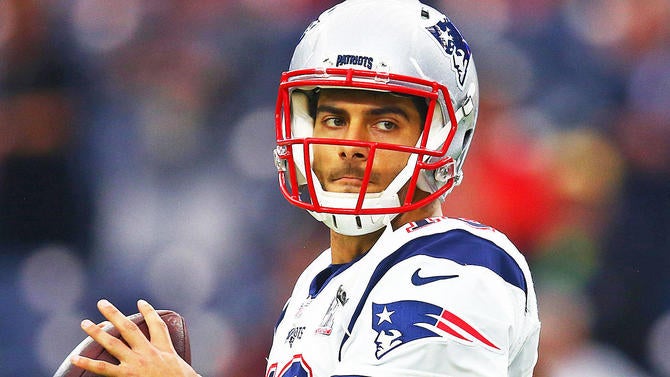
Armed with four of the first 65 picks in the upcoming draft, including the first overall pick and No. 12, the Browns have the draft capital to land Garoppolo, who was a second-round pick in 2014. Giving up the 12th overall selection or a 2018 first-round pick will likely be required instead of the 33rd overall pick (first pick in the second round).
It would be smart for any team acquiring Garoppolo to insist on him signing a long-term deal in the process. A franchise tag would probably be necessary in 2018, which could be as much as $23 million, if Garoppolo lives up to his potential while playing out his rookie contract. Garoppolo’s camp would presumably want a contract comparable to the four-year, $72 million deal containing $37 million fully guaranteed that Brock Osweiler received in free agency last year from the Texans after just seven career starts.
Griffin could be expendable if a veteran quarterback is acquired. The Browns would pick up nearly $7 million of cap space by letting Griffin go before he is due a $750,000 roster bonus on March 11.
Terrelle Pryor is one of the NFL’s most intriguing impending free agents after successfully making a difficult transition from quarterback to legitimate starting wide receiver. He emerged as Cleveland’s best and most reliable receiving option last season after Corey Coleman, a 2016 first-round pick, missed several games with a broken hand. The Browns were also without Josh Gordon, who remains indefinitely suspended for repeated violations of the NFL’s substance abuse policy.
Retaining the 6-foot-4, 223-pound speedster is a priority for the Browns. Preliminary contract extension talks were held with Drew Rosenhaus, Pryor’s agent, during the season and reportedly resumed recently. The $10,012,500 per-year extension that Rosenhaus got Allen Hurns from the Jaguars last offseason, which helps set the market for No. 2 wide receivers, could be the salary floor for the converted quarterback.
There has been some speculation that the Browns could use a franchise tag, which should be in the $15.8 million neighborhood, on Pryor because of an abundance of cap space. A transition tag for around $13 million might make more sense because it’s a better reflection of Pryor’s value than the franchise tag. It would be virtually impossible for another team to sign Pryor to an offer sheet that the Browns couldn’t match due to their favorable cap situation.
There’s a strong possibility that the first overall pick will be used on Texas A&M defensive end Myles Garrett, provided the Browns don’t trade down again. Cameron Erving, the No. 19 overall pick in 2015, struggled replacing Alex Mack at center after Mack’s departure in free agency. Erving had a decent outing at right tackle in the season finale. Erving also started four games at guard as a rookie. Whether he stays at center remains to be seen. Left guard Joel Bitonio avoiding the injury bug for the first time since his 2014 All-Rookie season would give the offensive line a boost.
San Francisco 49ers
Salary cap room projection: $76.535 million
Team needs: QB, WR, LB, interior DL
Key unrestricted free agents: K Phil Dawson, LB Gerald Hodges, QB Colin Kaepernick
Potential restricted free agent tenders: RB DaJuan Harris-$1.808 million
The preference for the 49ers has been building the roster primarily with home-grown talent in the draft. The philosophy hasn’t been successful in recent years because of lackluster drafts by former general manager Trent Baalke. The new regime, led by new GM John Lynch, a surprise choice because of his lack of NFL front office experience, and coach Kyle Shanahan, one of the game’s brightest young offensive minds, might be more active in free agency than their predecessors.
Quarterback stability is a primary concern for Shanahan, but he doesn’t necessarily have to find it this offseason. Lynch and Shanahan had a productive meeting with incumbent quarterback Colin Kaepernick on Wednesday. He is expected to opt out of the final year of his renegotiated contract with a $16.9 million 2017 salary between March 2 and March 7. Kaepernick isn’t the type of pocket passer Shanahan wants at quarterback anyway. The 49ers would pick up an additional $16.9 million of cap space from Kaepernick voiding his deal.
Kirk Cousins, who Shanahan had for the final two of his four years as Redskins offensive coordinator, fits that bill better than any potentially available quarterback. A second franchise tag from the Redskins is likely for Cousins. A trade could still be a possibility, provided it doesn’t involve San Francisco’s 2017 first-round pick, which is second overall. A fair approximation of Cousins’ trade value could be the draft capital that the Chiefs received from the Vikings for defensive end Jared Allen in 2008, even though quarterbacks are generally more valuable than pass rushers. In that swap, the Chiefs got the Vikings’ first-round pick (15th overall) and two third-round picks in the 2008 draft after Allen had been given a franchise tag. A swap of 2008 sixth-round picks was also a part of the trade.

A contract in the same ballpark as the five-year extension that Andrew Luck received from the Colts last offseason, which reset the NFL pay scale, would probably be necessary for Cousins. Luck’s extension averages $24.594 million and contains $87 million in guarantees, of which $47 million was fully guaranteed at signing.
Veteran Matt Schaub, who has a long history with Shanahan dating back to their days together with the Texans, could be a stopgap at quarterback. Cousins would be San Francisco’s top target in 2018 free agency if he becomes an unrestricted free agent after playing next season in Washington under a second franchise tag.
Redskins wide receiver Pierre Garcon’s familiarity with Shanahan’s offense could also come in handy. He probably isn’t looking to take a pay cut from the $8.5 million-per-year deal he got in 2012 when he joined the Redskins.
Shanahan will be making a switch to a 4-3 defense similar to what the Falcons ran over the past two years when he was their offensive coordinator. The 49ers ranked last in total defense (406.4 yards per game), run defense (165.9 yards per game) and points allowed (30 points per game) last season. The only true building blocks on defense are four-time first team All-Pro linebacker NaVorro Bowman, who is recovering from a torn Achilles, and defensive linemen Arik Armstead and DeForest Buckner, San Francisco’s top draft picks in 2015 and ‘16.
A mass exodus at cornerback over the past couple of years has made the secondary vulnerable. Weakening a division rival could be a sound strategy if the Rams don’t use another franchise tag on Trumaine Johnson for $16,742,400. He will likely target a deal that exceeds what his former Rams counterpart Janoris Jenkins received from the Giants in free agency last year. Jenkins’ deal averages $12.5 million per year with $28.8 million fully guaranteed.
Jacksonville Jaguars
Salary cap room projection: $68.002 million
Team needs: Interior OL, DE, TE, S
Key undrafted free agents: CB Prince Amukamara, S Johnathan Cyprien, OT/OG Luke Joeckel
Potential restricted free agent tenders: None
The Jaguars were a trendy preseason pick to challenge for a playoff berth in 2016. Landing a top-five pick in the draft for a sixth straight season instead led to Gus Bradley’s dismissal and former Jaguars coach Tom Coughlin returning as executive vice president of football operations with final say on personnel matters.
Jacksonville’s recent forays into the open market haven’t paid big dividends. Defensive end Jared Odrick and tight end Julius Thomas, the crown jewels of their 2015 free-agent class, will be in different uniforms next season. The Jaguars picked up $8.5 million of cap room by cutting Odrick.
Thomas is heading to the Dolphins once the trading period opens when the new league year begins March 9. In a separate transaction, left tackle Branden Albert, who is scheduled to make $8.9 million in 2017 and $9.6 million in ‘18, will be acquired from the Dolphins. The Jaguars are going to lose $4.2 million in the swap of these players.
Cornerback Davon House and linebacker Dan Skuta, two other 2015 free-agent signees, might also be on their way out; $10.1 million of cap room would be gained from their release.
These failures probably won’t deter aggressiveness in free agency. Improving the interior of the offensive line will likely be a top priority. T.J. Lang (Packers) and Kevin Zeitler (Bengals) headline a deep guard free-agent class. This duo could sign deals comparable to the $10 million-per-year contract extensions that David DeCastro and Kyle Long received from the Steelers and Bears as the start of 2016 regular season approached. Long’s deal has $30 million in guarantees. Ronald Leary (Cowboys) and Larry Warford (Lions) could command contracts in the next salary tier for guards, averaging in the range of $8 million annually with over $20 million in guarantees.
The pass rush could use an upgrade because of the lack of production from Odrick and Dante Fowler Jr., the third overall pick in 2015, in what was essentially his rookie year. Fowler missed the 2015 season after tearing the ACL in his left knee during his first rookie minicamp practice. Coughlin could target Jason Pierre-Paul, who he coached during his final six years with the Giants. Signing him to a long-term contract could require more than the $14.25 million per year (plus escalators) that defensive tackle Malik Jackson received from the Jaguars in free agency last year on his six-year deal, which contains $42 million in guarantees.
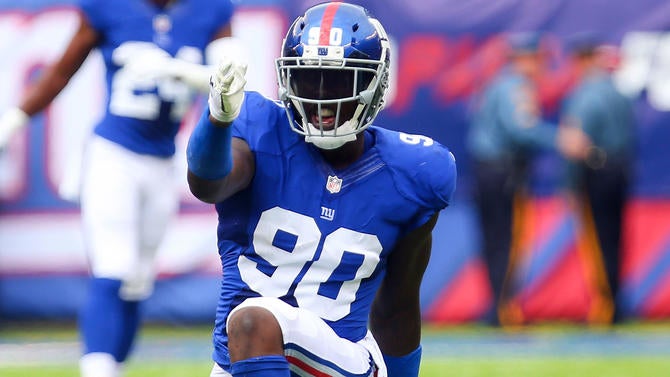
Thomas’ departure leaves a void at tight end. Jared Cook (Packers) and Jack Doyle (Colts) will be more affordable than Martellus Bennett, who is looking for a huge payday after helping the Patriots win Super Bowl LI. The $5 million per year that Ladarius Green received from the Steelers last offseason could be an important salary data point for these two.
Retaining cornerback Prince Amukamara, another former Coughlin player, might put him in the same salary range as Atlanta’s Robert Alford. Alford gave up a shot at free agency when he signed a late-season extension with the Falcons averaging $9.5 million and containing $21 million in guarantees to set the No. 2 cornerback market. Safety Johnathan Cyprien’s coverage limitations might make the Jaguars hesitant about making a significant investment in him after giving Tashaun Gipson a five-year, $36 million deal as a free agent last year.
New England Patriots
Salary cap room projection: $54.774 million
Team needs: DE, TE, CB, LB
Key unrestricted free agents: TE Martellus Bennett; RB LeGarrette Blount, ILB Dont’a Hightower; DE Chris Long, CB Logan Ryan; DE Jabaal Sheard
Potential restricted free agent tenders: CB Malcolm Butler-$3.933 million; OT Cameron Fleming-$1.808 million
The Patriots won Super Bowl LI despite trading two of their most talented defensive players. Chandler Jones, New England’s best pass rusher, was dealt to the Cardinals early last offseason. Linebacker Jamie Collins was shipped to Cleveland during the middle of the season because of “freelancing” on defense and exorbitant contract demands.
The Collins trade should have increased Hightower’s contract leverage and created more urgency for New England to retain him. It’s going to be hard for the Patriots to justify to Hightower that he should take less than the $12.5 million per year that the linebacker they traded away recently received from Cleveland. A franchise tag, which should be in the $14.75 million neighborhood, is a possibility because Hightower will be in high demand if he hits the open market.
Using the designation on Bennett for almost $9.9 million instead should be given consideration because of All-Pro tight end Rob Gronkowski’s inability to stay healthy. It’s conceivable that Bennett will get a deal in the neighborhood of $8.5 million per year, making him one of the NFL’s highest-paid tight ends, since he is clearly the best potentially available tight end and money is his primary consideration.
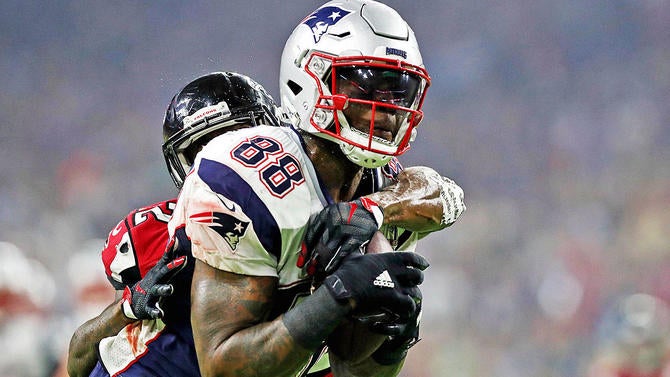
LeGarrette Blount wants to come back. His career-best 1,161 rushing yards were eighth most in the NFL in 2016 and he also had an NFL-best 18 rushing touchdowns. Tepid free-agency interest prompted him to return to New England on a one-year, $1 million deal worth up to $2 million through incentives in 2016. The Patriots should be willing to give him a short-term deal averaging at least the $1.75 million he made last season.
Restricted free agent Malcolm Butler could be in line for a new deal. He has been playing at a Pro Bowl level the past two seasons while making his league minimum salary. Since the Patriots can have his rights for the 2017 season at close to $4 million, a negotiation will center on the number of unrestricted free-agent years Butler gives up and their value. The range for these years could be Alford’s $9.5 million per year and the $12.5 million that Jenkins received on the open market last year. Unless the Patriots are willing to invest heavily in two cornerbacks, it might be difficult to retain Logan Ryan.
The Patriots will have a great backup quarterback situation if Jimmy Garoppolo, who is entering a contract year, isn’t traded. It will be hard for New England to turn down an offer involving a first-round pick.












